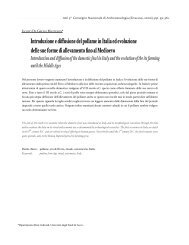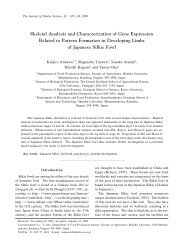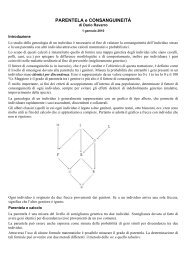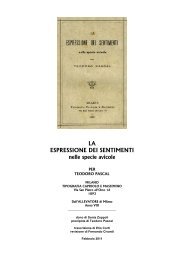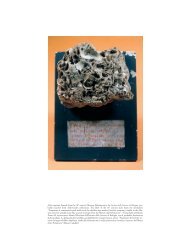Hamburger and Hamilton - Summa gallicana
Hamburger and Hamilton - Summa gallicana
Hamburger and Hamilton - Summa gallicana
You also want an ePaper? Increase the reach of your titles
YUMPU automatically turns print PDFs into web optimized ePapers that Google loves.
NORMAL STUES OF THE CHICK<br />
235<br />
NORMAL STAGES OF THE CEICK 53<br />
stage 10 of Saunders is identical with our stage 23. The developmental<br />
phase between 4 <strong>and</strong> 9 days of incubation is<br />
characterized by rapid changes in the wings, legs, <strong>and</strong> visceral<br />
arches. From the 8th to the 12th days, feather-germs <strong>and</strong><br />
eyelids provide the most useful criteria. The designation of<br />
stages during the last phase of incubation is difficult because<br />
practically no new structures are formed <strong>and</strong> there is mainly<br />
just growth of what almready exists. Hence, we have had to<br />
make use of measurements of the lengths of the beak <strong>and</strong> of<br />
the toes.<br />
The senior author is responsible for stages 14 to 35 <strong>and</strong> the<br />
junior author for all the others.<br />
All illustrations <strong>and</strong> descriptions are based on material<br />
fixed in Bouin's solution or formalin. It is possible that<br />
minor distortions have occurred due to differential shrinkage,<br />
for instance in the amnion. The embryos used for stages<br />
14 to 35 came from a flock of White Leghorns at St. Louis.<br />
They were incubated in a small size Buckeye incubator (for<br />
350 eggs) without forced draft, at a temperature of 1Q3"F.<br />
(ca. 39.4"C.). The embryos used for the other stages were<br />
of several breeds (White Leghorn, Barred Plymouth Rock,<br />
<strong>and</strong> Rhode Isl<strong>and</strong> Red) from the Iowa State College Poultry<br />
Farm, <strong>and</strong> were incubated in a forced-draft incubator at a<br />
constant temperature of 375°C. During the course of this<br />
work several hundred embryos have been examined <strong>and</strong> classified<br />
from the second day of incubation until hatching.<br />
We wish to express our great appreciation of the expert<br />
advice <strong>and</strong> help which Dr. Mary E. Rawles, Johns Hopkins<br />
University, <strong>and</strong> Dr. Nelson T. Spratt, University of Minnesota,<br />
have given us in the difficult matter of selecting stages<br />
1 to 6. Dr. Rawles has generously supplied data on the range<br />
of time within which a given stage may usually be obtained,<br />
based on records of 7 0 embryos incubated at 38°C. Her<br />
data are included iii the text for stages 5-14 <strong>and</strong> 22. Dr.<br />
Spratt has supplied photographs <strong>and</strong> slides for illustrating






